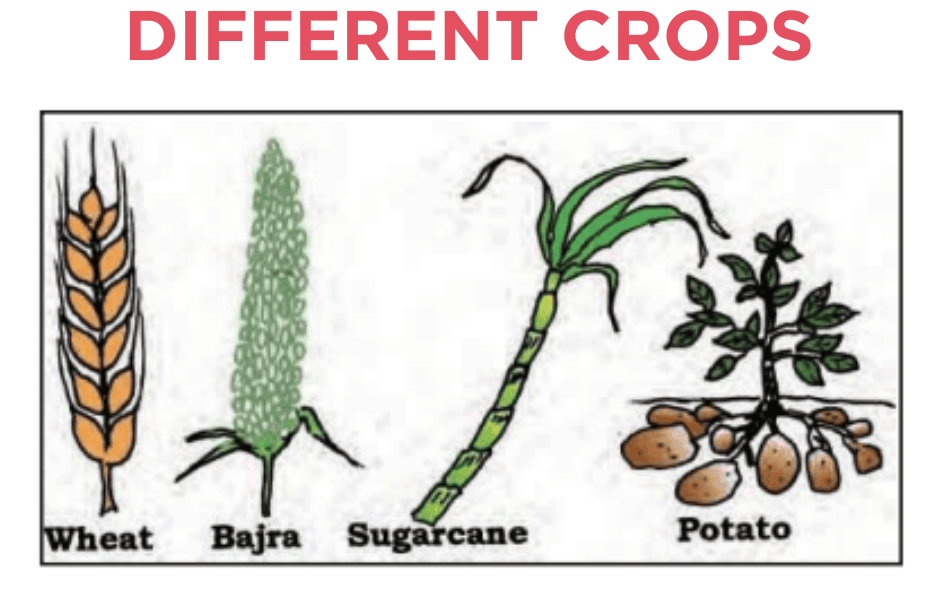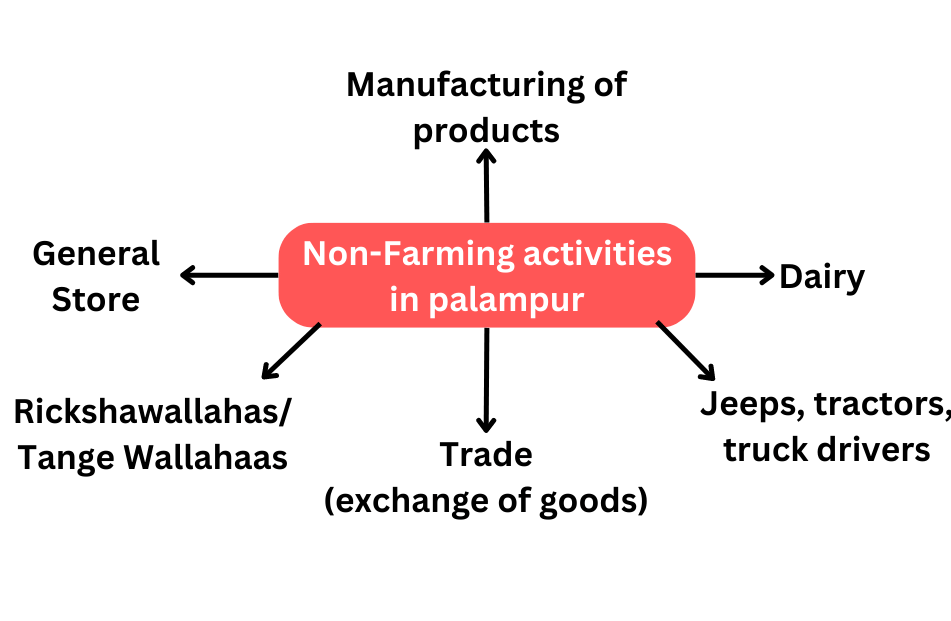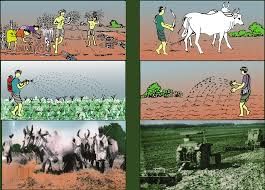Unit Test (Solutions): The Story of Village Palampur | Social Studies (SST) Class 9 PDF Download
Time: 1 hour
M.M. 30
Attempt all questions.
- Question numbers 1 to 5 carry 1 mark each.
- Question numbers 6 to 8 carry 2 marks each.
- Question numbers 9 to 11 carry 3 marks each.
- Question numbers 12 & 13 carry 5 marks each.
Q1: Which of the following is the main activity of the people in Palampur?
(i) Dairy
(ii) Farming
(iii) Shop-keeping
(iv) Transport
Ans: (ii) Farming
Farming is the primary activity in Palampur, with 75% of the people dependent on it for their livelihood.
Q2: Which one of the following crops is grown during the rainy season in Palampur?
(i) Wheat
(ii) Potato
(iii) Jowar
(iv) Sugarcane
Ans: (iii) Jowar
Jowar is grown during the Kharif season in Palampur and is primarily used as cattle feed.
Q3: The standard unit for measuring land in Palampur is __________.
Ans: Hectare
In Palampur, land is measured in hectares, though local units like bigha and guintha are also used.
Q4: Electricity in Palampur is mainly used for which of the following purposes?
(i) Lighting homes
(ii) Running small businesses
(iii) Irrigating fields through tubewells
(iv) Powering factories
Ans: (iii) Irrigating fields through tubewells
The arrival of electricity in Palampur transformed irrigation, enabling the use of electric run tubewells to irrigate larger areas of land.
Q5: The percentage of irrigated land in India is __________.
Ans: 40%
Approximately 40% of the cultivated area in India is irrigated, with the rest relying on rainfall.
Q6: Why is land considered a fixed capital of production in Palampur?
Ans: i) Limited Availability: The land area under cultivation in Palampur has not expanded since 1960, indicating that the amount of cultivable land is fixed.
ii) No Scope for Expansion: Wastelands have already been converted to cultivable land, leaving no further scope for increasing farm production by bringing new land under cultivation.
Q7: What role does irrigation play in the farming practices of Palampur?
Ans: i) Enables Multiple Cropping: The well-developed irrigation system, powered by electricity, allows farmers to grow three different crops in a year, significantly increasing agricultural productivity.
ii) Reduces Dependence on Rainfall: With the availability of tubewells for irrigation, farmers in Palampur can cultivate their lands even during dry spells, reducing their dependence on monsoon rains.
Q8: How do small farmers manage capital for farming in Palampur?
Ans: i) Borrowing: Small farmers often borrow money from large farmers, village moneylenders, or traders, usually at high-interest rates, to arrange for seeds, fertilizers, and other inputs.
ii) Repayment Challenges: The high cost of borrowing and low earnings from small plots of land often put small farmers under financial stress, making it difficult for them to repay loans.
Q9: Describe the non-farm activities practiced in Palampur.
Ans: i) Dairy Farming:
a) Many families in Palampur engage in dairy farming, feeding their buffaloes on grass, jowar, and bajra.
b) Milk is sold in Raiganj, where it is collected by traders and transported to distant towns and cities.
ii) Small-Scale Manufacturing:
a) Some villagers are involved in small-scale manufacturing, such as Mishrilal, who processes sugarcane into jaggery using a machine powered by electricity.
b) These activities are mostly carried out at home or in fields, with simple production methods.
iii) Shopkeeping and Transport:
a) A few families operate small general stores, selling everyday items like rice, tea, biscuits, and soap.
b) The transport sector is growing, with various vehicles ferrying people and goods between Palampur and neighboring towns.

Q10: Explain the different ways in which production on the same piece of land can be increased in Palampur.
Ans: i) Multiple Cropping:
a) Growing more than one crop on the same land in a year is a common method in Palampur.
b) For example, farmers grow jowar and bajra in the Kharif season, followed by potato, and then wheat in the Rabi season.
ii) Modern Farming Methods:
a) The use of High Yielding Variety (HYV) seeds, chemical fertilizers, and pesticides introduced by the Green Revolution has significantly increased the yield of crops like wheat.
b) This method, however, requires more capital and resources, such as irrigation and machinery.
iii) Efficient Irrigation: The introduction of electric tubewells has improved irrigation efficiency, allowing for better water management and the ability to cultivate more crops throughout the year.
Q11: Discuss the unequal distribution of land in Palampur and its impact on farmers.
Ans: i) Land Ownership:
a) About one-third of the families in Palampur are landless, with the majority being Dalits. The remaining 240 families own small plots of land, less than 2 hectares in size.
b) A small number of medium and large farmers own the majority of the land, with some owning more than 10 hectares.
ii) Impact on Small Farmers:
a) Small farmers struggle to make a living from their small plots, often requiring additional work or loans to sustain themselves.
b) The lack of sufficient land leads to lower production and limited surplus, making it difficult for them to save and invest in better farming practices.
iii) Economic Disparity: The unequal distribution of land contributes to economic disparity in the village, with large farmers accumulating more wealth while small farmers remain in poverty.
Q12: Discuss the various factors of production in the context of Palampur. How do these factors contribute to the overall production in the village?
Ans: i) Land: Land is a crucial factor of production in Palampur. It is limited in supply, and no additional land is available for farming expansion. The entire cultivable land in Palampur is already under cultivation. Efforts are made to maximize production through techniques like multiple cropping and modern farming methods.
ii) Labour: Labour is abundant in Palampur, with many families engaged in farming. Small farmers typically rely on family labour, while medium and large farmers hire farm labourers. Farm labourers in Palampur often belong to landless families or families with small plots of land. They work for wages, which vary by region, crop, and type of work.
iii) Capital: Capital is divided into two types: fixed capital (e.g., tools, machines) and working capital (e.g., seeds, fertilizers). Medium and large farmers usually have their own savings to invest in farming, whereas small farmers often borrow money at high interest rates to manage their farming needs.
iv) Human Capital: Knowledge and enterprise are essential for combining land, labour, and capital effectively. The ability to make informed decisions about crop choices, irrigation, and modern farming methods is crucial. In Palampur, the introduction of electricity has greatly enhanced agricultural productivity by enabling better irrigation and mechanization.
v) Overall Contribution: The combination of these factors of production allows Palampur to sustain its farming activities, increase yield, and support non-farm activities like dairy and small-scale manufacturing. The village’s economy is a reflection of how effectively these factors are managed and utilized.
Q13: Explain the challenges faced by small farmers in Palampur. How do these challenges impact their production and livelihood?
Ans: i) Limited Land Holdings:
a) Small farmers in Palampur typically own less than 2 hectares of land. The small size of their land holdings limits the amount of crop they can produce, leading to lower overall yields. With limited land, they cannot afford to leave land fallow, which further deteriorates soil quality over time.
ii) High Dependence on Loans: Due to the lack of sufficient savings, small farmers often need to borrow money to buy seeds, fertilizers, and other inputs. These loans usually come from large farmers or moneylenders at high interest rates. The burden of repaying these loans often forces small farmers to sell their produce at low prices and engage in additional work as farm laborers, further straining their financial situation.
iii) Low Access to Modern Inputs: Small farmers have limited access to modern farming tools and machinery. Unlike large farmers who can invest in tractors and advanced irrigation systems, small farmers must rely on traditional methods, which are less efficient.
iv) Vulnerability to Market Fluctuations: Small farmers often face difficulties in selling their produce at fair prices due to market fluctuations. Their lack of bargaining power and the small volume of produce make them vulnerable to exploitation by traders. The reliance on middlemen reduces their income, leaving them with just enough to cover basic needs and repay debts.
v) Impact on Livelihood: The challenges faced by small farmers lead to low productivity and income, making it difficult for them to sustain their livelihood solely through farming. Many small farmers are forced to seek additional employment as laborers or engage in non-farm activities to supplement their income. This situation contributes to the ongoing cycle of poverty and indebtedness in rural areas like Palampur. 
|
55 videos|525 docs|78 tests
|
FAQs on Unit Test (Solutions): The Story of Village Palampur - Social Studies (SST) Class 9
| 1. What are the main economic activities in Village Palampur? |  |
| 2. How does the Green Revolution impact agriculture in Palampur? |  |
| 3. What role does transportation play in the economic development of Palampur? |  |
| 4. How is the concept of self-sufficiency reflected in the lifestyle of Palampur villagers? |  |
| 5. What are the challenges faced by farmers in Palampur? |  |
















